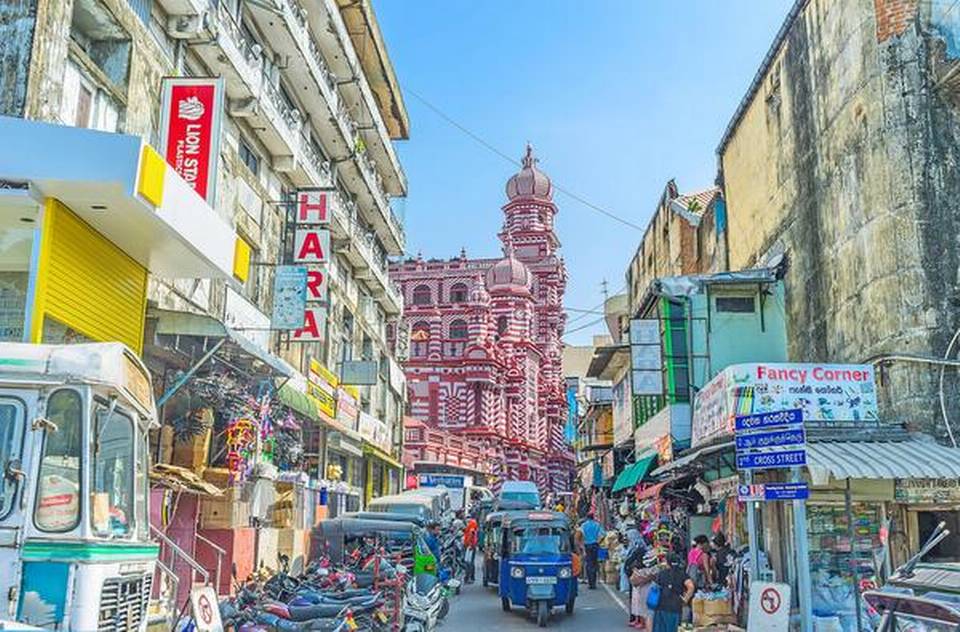I sit in the huge living room of the old governor s home in Jaffna. The walls, painted... a warm rose-red, stretch awesome distances away to my left, to my right and up towards a white ceiling. When the Dutch first built this house egg white was used to paint the walls. The doors are twenty feet high, as if awaiting the day when a family of acrobats will walk from room to room, sideways, without dismantling themselves from each other s shoulders. — Running in the Family, Michael Ondaatje
The first thing we notice as we enter the hotel in Galle is the massive winding staircase. As we ascend, climbing alongside us is a sculpture of the Portuguese-Sinhalese encounter on the battlefield: Sinhalese warriors and Portuguese invaders frozen into brass sheet and copper, with animals, weapons, cannons, pennants, all making their way intractably along the balustrading to a blue-tiled dome. It is sculptor Laki Senanayake s depiction of the Battle of Randeniwela, waged in 1630 between the Portuguese invaders and the Sinhalese warriors, with life-sized horses and horsemen, bows and arrows, a head on a spear, and above it all, the Sinhalese king playing the flute.
Trying to read up more about this battle, I find an essay by historical novelist and historian Gaston Perera in The Island. The Portuguese attack was led by the fidalgo Constantino de Sá de Noronha, who would be killed in battle. A Portuguese account of the fierce clash mentions that a thunderstorm had soaked the Portuguese firepower. Perera adds that this detail is indirectly confirmed by a local story: The belief among the villagers is that a party of Kandyan archers was stationed here during the fighting with orders to shoot fire arrows — arrows tipped with burning arecanut husk, kamaranka puwak — at the place where the Portuguese had spread their powder out to dry. This oral tradition has nothing to say about a storm but why should the Portuguese have to dry their powder?”
It was a decisive victory for the Sinhalese.
A building can only be understood by moving around and through it, and by experiencing the modulation, and feel the spaces one moves through — from outside into verandah, then rooms, passages, courtyards. Architecture cannot be totally explained but must be experienced. It should play to all the senses — the smell of vegetation after rain, the sound of birds, and the wind in trees. — Geoffrey Bawa
Designed by legendary Sri Lankan architect and landscape artist Geoffrey Bawa, the hotel is named after the Galle Lighthouse. Built on a promontory outside the 17th century Dutch Fort, the massive rocks are part of the design: they are showcased like stone sculptures that deserve to be looked at.
For a country so full of luxuriant natural beauty, Sri Lanka s architecture is equally striking. Even the buildings seem to spring from the ground fully formed, like the stalks of plants emerging with a powerful motivation from the soil. We are on the first floor and close enough to feel the spray. The waves crash against the rocks. The breakers are brilliantly white.
On a landing, an artist from Colombo has set up a stall where he is making miniature paintings on white pebbles. Our 10-year-old son befriends him and buys a bunch of handpainted bookmarks and pebbles. He saves his phone number into my phone: Artist, Colombo.
Colombo has its memories. Much poignancy, too, if we could dig deep enough through the concrete and asphalt that has carpeted it for miles in most directions. — Colombo, Carl Muller
As we reach Colombo, on one of the alarmingly narrow U-turns, our vehicle makes contact with a Volkswagen Beetle. Our driver stops the car in the middle of the road — not difficult in the traffic that s barely moving — and so does the other driver, who is wearing a t-shirt and cargo shorts, as if he s headed for a day at the sports ground.


